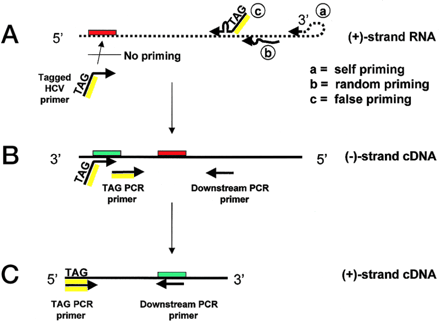A Tale of Two Strands: Reverse-Transcriptase Polymerase Chain Reaction Detection of Hepatitis C Virus Replication
Fig. 1. Potential causes of nonspecific amplification of positive-strand RNA sequence by using tagged RT-PCR. (A) Conventional reverse transcription of RNA into cDNA at 42°C with the minus-strand specific tagged HCV primer can lead to nonspecific synthesis of cDNA from positive-strand RNA by virtue of (a) self-priming, (b) random prining, or (c) false priming. (B) These nonspecific cDNAs along with some of the tagged primer will be transferred into the subsequent PCR reaction mix. The tagged HCV primer (through its HCV-complementary sequence) can now use the nonspecifically amplified cDNA as template during the first cycle of the PCR reaction. (C) In further PCR cycles, amplification of the target by the PCR primers (tag primer, which lacks HCV sequence, and the downstream HCV primer) leads to a false-positive result. RNA is shown as dotted lines, and DNA as solid lines. “Active” primer sites appear green, whereas “inactive” primer sites are red. The tag sequence is shown in yellow.





